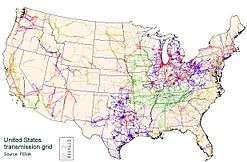North American Electric Reliability Corporation
 The four NERC Interconnections, and the eight NERC Regional Reliability Organizations` | |
| Abbreviation | NERC |
|---|---|
| Formation | March 28, 2006 |
| Founded at | Atlanta, Georgia |
| Type | 501(c)(6) |
| 20-4821888 | |
| Legal status | Active |
| Headquarters | Atlanta, Georgia |
| Coordinates | 33°50′51″N 84°22′00″W / 33.847404°N 84.366719°WCoordinates: 33°50′51″N 84°22′00″W / 33.847404°N 84.366719°W |
Region | Contiguous United States, Canada and a portion of Baja California in Mexico |
Membership (2015) | 1,900+[1] |
President & CEO | Jim Robb |
| Mark Lauby | |
Sr. VP, CFO, & Treasurer | Michael Walker |
Sr. VP & CSO | (Vacant) |
| |
| Subsidiaries | |
Budget (2015) |
|
Staff (2015) | 198[3] |
| Website |
www |
Formerly called | North American Electric Reliability Council |
The North American Electric Reliability Corporation (NERC) is a nonprofit corporation based in Atlanta, Georgia, and formed on March 28, 2006, as the successor to the North American Electric Reliability Council (also known as NERC). The original NERC was formed on June 1, 1968, by the electric utility industry to promote the reliability and adequacy of bulk power transmission in the electric utility systems of North America. NERC's mission states that it is to "ensure the reliability of the North American bulk power system."[4]
NERC oversees eight regional reliability entities and encompasses all of the interconnected power systems of the contiguous United States, Canada and Mexico.
NERC's major responsibilities include working with all stakeholders to develop standards for power system operation, monitoring and enforcing compliance with those standards, assessing resource adequacy, and providing educational and training resources as part of an accreditation program to ensure power system operators remain qualified and proficient. NERC also investigates and analyzes the causes of significant power system disturbances in order to help prevent future events.
Origins
Originally formed as a voluntary organization in 1968 by the electricity industry and called the National Electric Reliability Council, the name was changed to include "North American" in place of "National" in 1981 in recognition of Canada's participation and the broader scope of NERC's footprint. The name was changed from "Council" to "Corporation" in 2007.
In 2000, NERC established the Electricity Sector Information Sharing and Analysis Center, which provides industry with timely responses and alerts on cyber and physical security threats that have the potential to impact the bulk power system. The ES-ISAC, which changed its name in 2015 to Electricity Information Sharing and Analysis Center, shares timely information with industry through its secure web portal.
In August, 2003, North America experienced its worst blackout to date, as 50 million people lost power in the Northeastern and Midwestern United States and Ontario, Canada. A United States–Canada Power System Outage Task Force was formed to investigate the causes of the blackout and to make recommendations to prevent future blackouts.
The Energy Policy Act of 2005 called for the creation of an Electric Reliability Organization (ERO) to develop and enforce compliance with mandatory reliability standards in the United States. This non-governmental, "self-regulatory organization" was created in recognition of the interconnected and international nature of the bulk power grid.
In April 2006, NERC applied for and was granted the designation of the ERO by FERC in July 2006. NERC also filed the first set of mandatory Reliability Standards with FERC, as well as filing the same information with the Canadian provincial authorities in Alberta, British Columbia, Manitoba, New Brunswick, Nova Scotia, Ontario, Quebec, Saskatchewan, and with the National Energy Board of Canada.
FERC approved 83 NERC Reliability Standards in March 2007, making them the first set of legally enforceable standards for the U.S. bulk power system effective on June 2007. Although significant disturbances continued to occasionally occur, the formation of an ERO undoubtedly played a significant role in minimizing the impact and frequency of these events.
About NERC
The ERO's key programs, which impact more than 1,600 bulk power system owners and operators, are based on four pillars of continued success:
- Reliability – to address events and identifiable risks, thereby improving the reliability of the bulk power system.
- Assurance – to provide assurance to the public, industry, and government for the reliable performance of the bulk power system.
- Learning – to promote learning and continuous improvement of operations and adapt to lessons learned for improved bulk power system reliability.
- Risk-based Approach – to focus attention, resources, and actions on issues most important to bulk power system reliability.
NERC Reliability Standards
NERC Reliability Standards are developed using an industry-driven, American National Standards Institute-accredited process that ensures the process is open to all persons who are directly and materially affected by the reliability of the North American bulk power system; transparent to the public; demonstrates the consensus for each standard; fairly balances the interests of all stakeholders; provides for reasonable notice and opportunity for comment; and enables the development of standards in a timely manner. NERC's ANSI-accredited standards development process is defined in the Standard Processes Manual and guided by reliability and market interface principles.
NERC Reliability Standards define the reliability requirements for planning and operating the North American bulk power system and are developed using a results-based approach that focuses on performance, risk management, and entity capabilities. The Reliability Functional Model defines the functions that need to be performed to ensure the bulk power system operates reliably and is the foundation upon which the mandatory Reliability Standards are based.
The Standards Committee oversees and prioritizes NERC's standards development activities. The Standards Committee also coordinates NERC's development of Reliability Standards with the North American Energy Standards Board's (NAESB) wholesale electric business practices. Standards drafting teams, which are made up of industry volunteers and supported by NERC staff, work collaboratively to develop requirements using results-based principles that focus on three areas: measurable performance, risk mitigation strategies and entity capabilities. NERC's standards are mandatory and enforceable throughout the United States and several provinces in Canada. Entities in the United States found to be in violation of a standard can be subject to fines of up to $1 million per day per violation.
Electricity Information Sharing and Analysis Center
NERC also operates the Electricity Information Sharing and Analysis Center (E-ISAC). The E-ISAC offers security services to bulk power system owners and operators across North America. E-ISAC member services includes specific cyber and physical security threat intelligence, tailored cyber security knowledge and physical security collaboration. The E-ISAC, which NERC established at the request of the U.S. Department of Energy, works closely with NERC's Bulk Power System Awareness team in Atlanta to monitor real-time cyber and physical security threats to the grid.
The E-ISAC, through capabilities including its Cybersecurity Risk Information Sharing Program (CRISP), works with critical asset owners and operators to analyze real-time cyber and physical security data for patterns of incidents with the potential to impact the bulk power system. NERC has a "firewall" separating the E-ISAC and NERC's compliance and enforcement activities. The separation extends to a physical separation of the E-ISAC from the rest of NERC.
Interconnections and Regional Entities

Interconnections
- The Eastern Interconnection covers most of eastern North America, extending from the foot of the Rocky Mountains to the Atlantic seaboard, excluding most of Texas. The Eastern Interconnection is tied to the Western Interconnection via high voltage DC transmission facilities and also has ties to non-NERC systems in northern Canada.
- The Western Interconnection covers most of western North America, from the Rocky Mountains to the Pacific coast. It is tied to the Eastern Interconnection at six points, and also has ties to non-NERC systems in northern Canada and Northwestern Mexico.
- The Texas Interconnection covers most of the state of Texas. It is tied to the Eastern Interconnection at two points, and also has ties to non-NERC systems in Mexico.
- The Quebec Interconnection covers the province of Quebec and is tied to the Eastern Interconnection at two points. About one third of Canada's installed power (42 GW out of 130) and about one third of Canada's production (184 TWh out of 567) are in this interconnection. Despite being a functionally separate interconnection, the Quebec Interconnection is often considered to be part of the Eastern Interconnection.
Regional Entities
NERC Authority
As part of the fallout of the Northeast Blackout of 2003, the Energy Policy Act of 2005 authorized the Federal Energy Regulatory Commission (FERC) to designate a national Electric Reliability Organization (ERO). On July 20, 2006, FERC issued an order certifying NERC as the ERO for the United States. Prior to being the National ERO, NERC's guidelines for power system operation and accreditation were referred to as Policies, for which compliance was strongly encouraged yet ultimately voluntary.
NERC has worked with all stakeholders over the past several years to revise its Policies into Standards, and now has authority to enforce those standards on power system entities operating in the United States, as well as several provinces in Canada, by way of significant financial penalties for noncompliance.
In September 2018, the Federal Energy Regulatory Commission (FERC) and NERC opened a joint investigation into a "winter load event" earlier in January that stressed the electrical grids in the Midwest. On January 17, Midwest and U.S. south central grid operators ordered emergency appeals for electricity conservation. This was due to high power demand caused by cold weather.[5]
See also
References
- ↑ "NERC Membership List". North American Electric Reliability Corporation. 2015. Retrieved 29 October 2015.
- ↑ "2015 NERC Budget" (PDF). NERC. 13 August 2014. p. 7. Retrieved 29 October 2015.
- ↑ "NERC Staff" (PDF). NERC Roster. North American Electric Reliability Corporation. 9 October 2015. pp. 44–65. Retrieved 30 October 2015.
- ↑ "NERC".
- ↑ Bade, Gavin (2018-09-13). "FERC, NERC open inquiry into winter load event that stressed Midwest grids". Utility Dive. Retrieved 2018-09-13.
External links
- Official website

- NERC Board of Trustees
- NERC Management
- NERC Standards
- NERC Reliability Risk Management
- Electricity Information Sharing and Analysis Center (E-ISAC)
- NERC's Annual Long-Term, Seasonal and Special Reliability Assessments
- NERC Newsroom
- Key Players
- Understanding the Grid
- Ensuring Reliability of the Bulk-Power System
- Time error correction and reliability